
Chinstrap penguins get their name from the thin black line under their chins, which looks like a strap (带子) holding on a black hat or helmet. Like other penguins, they spend much of their time in the water, catching fish to eat. But when the time comes to raise their young, they return to land.
1.How did chinstrap penguins get their name?
A From their voice.
B From their appearance.
C From their behaviour.
D From their intelligence.
解析:选B。B 细节理解题。根据第一段第一句“Chinstrap penguins get their name from the thin black line under their chins, which looks like a strap holding on a black hat or helmet.”帽带企鹅的名字来源于它们下巴下面的一条细黑线,看起来像系在黑色帽子或头盔上的带子。由此可知,它们是因为外形而得名。故选B。
2.Which of the following sentences can be put in the “ ▲ ”?
A The number of penguins is declining.
B Chinstrap penguins face threats from big birds.
C Raising young penguins is a challenge.
D Penguins’ natural environment needs improving.
解析:选C。C 段落大意题。根据第二段描述的大意:企鹅在抚育后代时,小企鹅会面临许多威胁,因此企鹅父母中的一个需要照看幼崽,另一个需要去觅食。由此可知,本段主要介绍了抚养小企鹅时所面临的挑战。故选C。
3.What were the scientists curious about?
A Whether the penguin’s parents were sleeping.
B Why the chinstrap penguins blinked constantly.
C How to measure the brain activity of the penguins.
D What the penguins’ parents did to protect their babies.
解析:选A。A 推理判断题。根据第三段第二句“He wondered if more was happening than just blinking.”他想知道企鹅除了眨眼之外,是否还进行了更多活动;以及倒数第二句“Eleven days of studying the penguins revealed that the tired parents were actually sleeping in short bursts”对企鹅进行了11天的研究,发现疲惫的企鹅父母实际上是在短时间地睡觉。由此可知,科学家们之所以对帽带企鹅进行研究,是因为他们很好奇它们在眨眼之余是否在睡觉。故选A。
4.Why does the study impress sleep specialists of animals?
A It studied the sleeping pattern of penguins fully.
B It revealed the benefits of microsleeps to penguins.
C It was conducted in the natural habitat of penguins.
D It helped us know how penguins adapt to harsh conditions.
解析:选C。C 细节理解题。根据最后一段的“But scientists who study how animals sleep say that this is an important study, and especially impressive because it was carried out in the penguins’ natural environment.”但是研究动物睡眠方式的科学家说,这是一项重要的研究,尤其令人印象深刻的是,这项研究是在企鹅生存的自然环境中进行的。故选C。